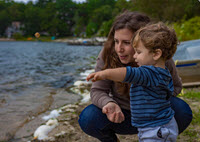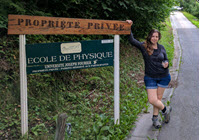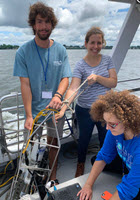
Predicting where oil will go can be one of the most challenging aspects of marine oil spill response. Following Deepwater Horizon, research showed that strong currents capable of transporting oil often appear along ocean fronts (the interface between river like-water masses that have different temperatures, salinities, or densities). However, our limited understanding about ocean front formation and the influence of turbulence, upper ocean mixing, and submesoscale currents (which can cause floating material to cluster and then spread out) inhibits the accuracy of ocean transport prediction models. Abigail Bodner uses mathematical theory and large eddy simulation (LES) models to improve our understanding about how different turbulence and mixing processes affect the behavior and development of ocean fronts.
Abigail is a Ph.D. student with Brown University’s Department of Earth, Environmental, and Planetary Sciences and a GoMRI Scholar with the Consortium for Advanced Research on Transport of Hydrocarbons in the Environment III (CARTHE-III).
Her Path

Abigail grew up in Israel, where she taught and tutored high school math before pursuing theoretical mathematics at Tel Aviv University. Although she enjoyed her studies, she felt like something was missing. She added earth sciences as a second major and fell in love with atmospheric and oceanic fluid dynamics, which allowed her to use mathematical tools to describe natural phenomena. She completed an atmospheric dynamics master’s degree at Tel Aviv University, where she researched how large-scale atmospheric circulation patterns can cause blocking events associated with temperature fluxes for certain topographies.
Although her master’s research focused heavily on theoretical models, its applications extended to pressing environmental concerns such as heat waves and harsh cold winters. Abigail felt motivated to find a physical oceanography doctoral program that would allow her to combine theory and modeling for research addressing environmental impacts. A professor working with Dr. Baylor Fox-Kemper at Brown University recommended that Abigail contact Fox-Kemper related to his research adapting LES modeling for float, tracer, and surfactant applications.

“After contacting Dr. Fox-Kemper, he responded within minutes, and we set up a Skype meeting where he told me all about the Gulf of Mexico Research Initiative,” Abigail said. “I was eager to be part of a larger research community working hard to help protect Gulf of Mexico ecosystems and coastal communities from environmental disasters.” She joined Dr. Fox-Kemper’s research group as a Ph.D. student, while also working towards a second master’s degree in applied mathematics.
Her Work
Abigail’s research started with paper, a pencil, and mathematical theory. She knew that previous research established a numerical theory that describes general ocean front dynamics but also knew that it lacked turbulence parameters. She modified the theory to include her hand-written equations that account for submesoscale (typically 102 – 104 meters in length and lasting hours to days in time scales) turbulence and then consulted a numerical computer program to solve the higher-level equations. As she used numerical methods to resolve the modified theoretical equations, she noticed an interesting pattern: turbulence from vertical mixing processes appeared to strengthen the front, while turbulence from horizontal mixing processes appeared to weaken it.

“It’s important to note that whether this pattern is true or not in a more realistic environment isn’t clear because the theory is very idealized. Factors like waves, wind, and cooling and heating can all be very chaotic, and in order to apply them cleanly in the theory you have to simplify them,” explained Abigail. “By distinguishing them into horizontal and vertical processes, we’re able to quantify their roles in affecting the front. But, if we really want to understand what they are doing, then we need a model like the LES that can simulate each of these processes.”
Abigail is validating her modified theory using a LES developed by Dr. Fox-Kemper and his collaborators (Dr. Jim McWilliams, University of California Los Angeles; Dr. Peter Sullivan, National Center for Atmospheric Research; and Dr. Luke Van Roekel, Los Alamos National Laboratory). She incorporates as many missing parameters as possible into the simulation and compares its results with the results of her modified theory.
Abigail explained that, while LES can help validate her numerical theory, her theory can also help researchers understand the LES results. “My theoretical equation can give us a road map of how to interpret these large eddy simulations. It can help us understand what is happening with the vertical and horizontal processes by stripping away their complexity and presenting them in a more-simplified world,” she said. “If we look at the LES’s more-complicated scenarios but still have in mind what we know happens under simpler conditions, it can provide clarity and help us be more focused when we analyze these complex simulations.”

Abigail plans to implement her theory into global climate models as an improved submesoscale parameterization that contributes to more accurate climate model predictions. Climate models use submesoscales to help determine the depth of the ocean mixed layer (the uppermost ocean layer), which helps define how the atmosphere and ocean will interact. Abigail explained that her two-year-old son is her greatest source of motivation to help enhance climate models. “Looking forward at climate predictions, it is hard to imagine what kind of world my son and future generations will have,” she said. “Being part of climate research is exciting, but it also comes with a sense of obligation to improve our current understanding of the climate system, including climate theory and predictions.”
Her Learning
Dr. Fox-Kemper has been a constant support and motivator for Abigail and has helped her strengthen her writing and communication skills. She further honed these skills teaching oceanography and climate science courses through Brown University’s Summer@Brown program.

Working with Dr. Fox-Kemper taught Abigail that she must dig deep to gain a more complete understanding of a scenario’s underlying physics while also connecting with bigger picture questions, existing literature, and community interests. Abigail’s experiences helped her gain a deeper appreciation for the scientific and peer-review processes involved in publishing. “[In research], you don’t always end up doing what you set out to do, but the result will probably be more interesting than anyone could have anticipated. It is exciting and confusing, which is part of what makes it so great,” said Abigail. “It is inspiring to be part of a community that cares deeply about the science as well as the coastal communities and ecosystems, which is what brings the GoMRI community together.”
Her Future
Abigail hopes to find a postdoc position that includes teaching and research where she can connect science to people’s lives, especially research related to sea level rise and its effects on coastal communities. She encourages students considering a scientific career not to feel intimidated by unfamiliar terminology. “It’s important to remember that, although it may be a slow learning curve, eventually you will learn how to use these terms yourself,” she said. “Have confidence in yourself, and don’t be afraid to ask for help. Most everyone will be excited to discuss their work with new students. You just need to work up the courage to ask. No question is a dumb question!”
Praise for Abigail
Dr. Fox-Kemper praised Abigail’s sharp mathematical mind. He recalled that initially she was more comfortable manipulating equations than interpreting data but quickly grew into an astute data analyst. “She is very quick to appreciate the significance of subtleties between different approaches to solving problems and has developed some new methods to address problems that have stumped theoreticians for decades – as well as finding some new problems of her own!” he said.
Dr. Fox-Kemper expressed admiration for Abigail’s ability to balance family and work, a feat he says was often difficult for him. “She keeps making progress on research and finding time to take opportunities to teach [while also spending time with her family],” he said. “She is a great role model for her kids and for other students thinking about becoming parents.”
The GoMRI community embraces bright and dedicated students like Abigail Bodner and their important contributions. The GoMRI Scholars Program recognizes graduate students whose work focuses on GoMRI-funded projects and builds community for the next generation of ocean science professionals. Visit the CARTHE website to learn more about their work.
By Stephanie Ellis and Nilde Maggie Dannreuther. Contact sellis@ngi.msstate.edu for questions or comments.
************
The Gulf of Mexico Research Initiative (GoMRI) is a 10-year independent research program established to study the effect, and the potential associated impact, of hydrocarbon releases on the environment and public health, as well as to develop improved spill mitigation, oil detection, characterization and remediation technologies. An independent and academic 20-member Research Board makes the funding and research direction decisions to ensure the intellectual quality, effectiveness and academic independence of the GoMRI research. All research data, findings and publications will be made publicly available. The program was established through a $500 million financial commitment from BP. For more information, visit https://gulfresearchinitiative.org/.
© Copyright 2010-2019 Gulf of Mexico Research Initiative (GoMRI) – All Rights Reserved. Redistribution is encouraged with acknowledgement to the Gulf of Mexico Research Initiative (GoMRI). Please credit images and/or videos as done in each article. Questions? Contact web-content editor Nilde “Maggie” Dannreuther, Northern Gulf Institute, Mississippi State University (maggied@ngi.msstate.edu).
